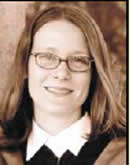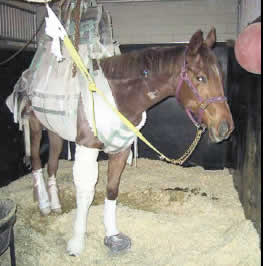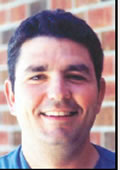|
|

 By Clare Illingworth,
By Clare Illingworth,
SPARK writer,
University of Guelph |
Slinging
away the blues
Using a sling to mend a broken leg proves uncommon
but successful |
Fracture repair
in horses can be a frustrating experience. Long term use of a full body
sling for fracture repair is unusual as very few horses can adapt to it.
But one tenacious patient conquered a potentially fatal fracture with
the help of her devoted owners, top-notch surgeons, and expert post-operative
care—while slung from the ceiling for three-and-a half months!
This was the case of Kyra, a 20- month-old Trakhaner filly, who suffered
a broken leg after a paddock accident in January 2002. She was brought
to the Ontario Veterinary College (OVC) in Guelph where a team led by
surgeon Dr. Antonio Cruz treated her.
“The fracture was a challenging one to repair because it was very
close to the knee and was displaced and had many fragments,” said
Dr. Cruz.
After a lengthy discussion
with the surgical team, owners Kevlynn and Barb Sacrey of Waterloo decided
to proceed with a transfixation cast, a technique that involves steel
pins being placed side to side above the fracture site and incorporated
into a whole leg cast.
“The advantages and disadvantages of each approach were thoroughly
explained,” said Kevlynn Sacrey. “I have raised this horse since
birth. While we knew there was only a 10 per cent chance of recovery,
we had to try.”
Kyra was revived from the surgery and anaesthesia on a special tilt table.
This helped her to avoid the struggle of getting up after general anaesthesia
with a full leg cast in place.

Kyra adapted to her new life of being slung from the ceiling, which
many horses are unable to do. (Photo: A. Cruz)
While the surgery and recovery were successful, there was still a long
healing process to follow. Long bone fractures are difficult to heal in
mature horses. During recovery it is difficult to rest a wounded leg while
preventing stress injury to the supporting legs. Orthopedic implants cannot
sustain heavy loads for extended periods of time; add to this the horse’s
“fight or flight” nature, and their slow healing process, and
you have a
good chance for post-operative complications. Using a sling to relieve
the load on the limbs presents a viable option, but long-term use of a
sling may cause secondary problems, including severe pressure sores and
serious digestive complications, such as colic.
Kyra spent three-and-a-half months in the sling at the OVC Large Animal
Clinic, where the majority of her 500 kg body weight was partially supported
off her legs allowing the fracture to heal. She quickly mastered suspended
slumber, and meals were fed on a platform.
“It is extremely unusual for a horse to adapt to a sling as well
she did,” said Dr. Cruz. “She was a trooper.”
Kyra was not alone
in her battle. The Sacreys’ dedication was apparent, with regular
visits and a party held at the clinic on her second birthday. Her recovery
was taken one day at a time and optimism and perseverance proved to be
the key to Kyra’s success. Both Dr. Cruz and the Sacreys have expressed
mutual admiration for their efforts and patience during the long recovery.
“We were so fortunate to have such a great staff helping Kyra, especially
Dr. Cruz,” said Sacrey. “Because of his handy work we still
have our horse.”
Kyra walked steadily out of the clinic on June 1, but will spend another
seven weeks in a stall, be hand walked, and undergo rehabilitation exercises
before having a final set of x-rays. She will have a permanent gait abnormality,
but otherwise will be in good health. That means she’ll likely have
a promising broodmare career, because of her
impressive bloodline.
 |
Dr.
Cruz, who hails from Spain, was hired by the University of
Guelph’s Large Animal Clinic as a staff surgeon in 1999.
Dr. Cruz specializes in cardiovascular physiology and endoscopic
surgery. When not pioneering new surgical techniques for horses,
Cruz studies postoperative care and
hopes to look at the caloric demands of surgery and recovery at
the hospital, with the aim of reducing the weight loss that is
so commonly associated with illness.
“Looking at the metabolic effects in combination with a minimally
invasive surgical procedure may greatly improve the
care we can provide at OVC,” says Dr. Cruz.
|
www.erc.on.ca
|

